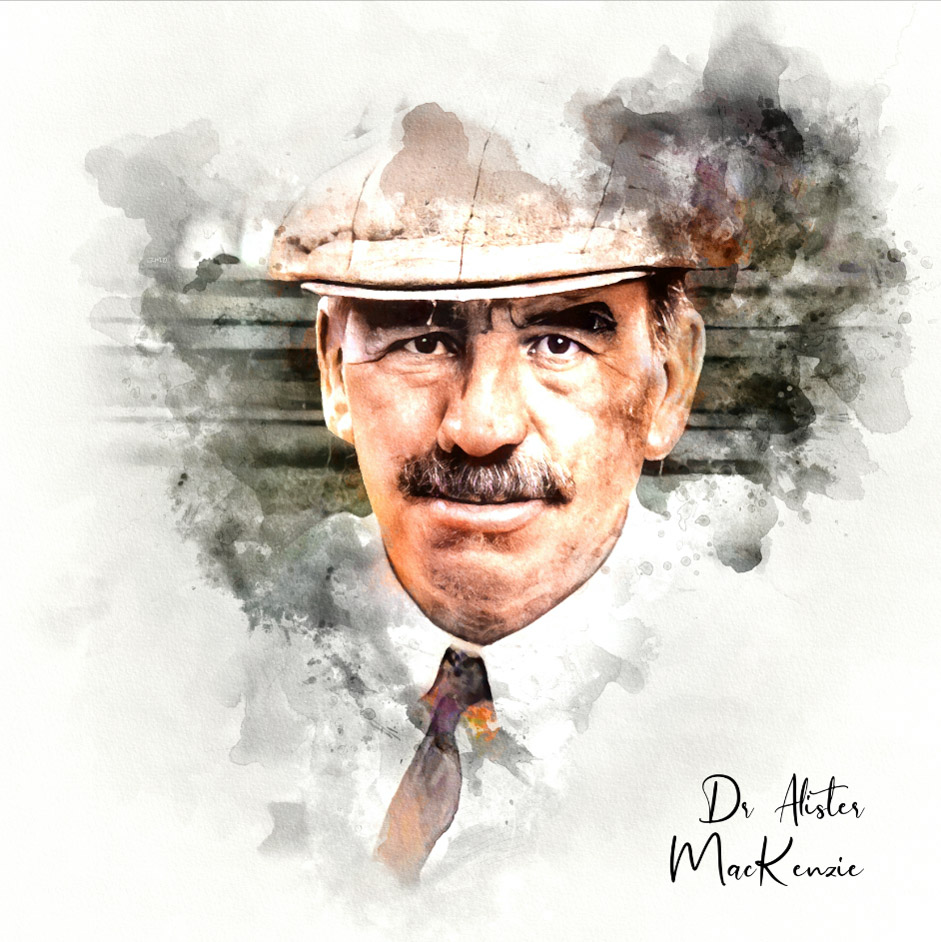Coombe Hill Golf Club

Overview
Coombe Hill Golf Club was once called JF Abercromby's first love and masterpiece. Much like Worplesdon, Park Jr contributed the routing and Abercromby the bunkers and greens.
The membership roll is a who's who of British high society:
- Politicians AJ Balfour, Winston Churchill, Herbert Henry Asquith, and David Lloyd George
- Writers W Somerset Maugham and Ian Flemming
- HRH King Edward the VIII and HRH King George VI
In addition, four Open Champions have served as professionals to the club: Arthur Havers, Sandy Herd, Henry Cotton & Dick Burton.
General Dwight D Eisenhower used the cottage behind the 14th tee as a secret hideaway during WW2.
Golf Course Review
The origins of Coombe Hill Golf Club were reported on 31 December 1909 that the golf course had been planned, staked off and 80 acres of trees were scheduled for removal commencing on January 3, 1910. A similar announcement followed in the Halifax Evening Courier on 1 January 1910. The article stated that Willie Park Jr had at that point planned the course with construction reportedly beginning on 10 January 1910.
At some point, it would be JF Abercromby who would be credited with the course design. It is well known that JF Abercromby measured distances by feel and eye. Legend has it he surveyed the site at Coombe Hill in a hot air balloon. To what extent Abercromby was involved with routing is unknown but it would appear it was led by WilliePark Jr.
Their efforts culminated in the opening of the Coombe Hill Golf Club on May 30, 1911. The Daily Telegraph, on May 31, 1911, reported the course was turned from woodland to first-class links in less than 6 months. It also mentioned that Carter's had been responsible for sowing the seed.
Open Champion Sandy Herd & Coombe Hill Golf Club
Sandy Herd was invited to be the club's first professional. It was reported he visited the club in January of 1911 and at that time the course was nearing completion despite forecasting a June opening. (Aberdeen Press and Journal 26 January 1911) The official statement of Herd's acceptance of the post was made by the secretary of the club, JF Abercromby, on 14 February 1911 and reported in the Leicester Daily Post. Sandy Herd officially became the first professional of Coombe Hill Golf Club on 1 May 1911.
Coombe Hill Golf Club's Design
In 1935, it was reported by Brer Rabbit that Coombe Hill Golf Club measured just 6197 yards. Despite this, it was still considered to be an 'enjoyable but adequate test of golf.' Described as strategic, Coombe Hill was described as an 'intelligent golfer's course.'
The course isn't particularly long by modern standards. The Par 5's are all less than 500 yards, averaging 479 yards. A case could be made that for the elite, there are no 3 shot holes on the course. The eleven remaining holes provide a varied test. Of the 11 par 4's, four are less than 350 yards and four are more than 400 yards.
Coombe Hill's Par 3's
The four one-shot holes are all less than 200 yards. One measuring just 142 yards and the other 3 averaging 182 yards. Despite them following the same pattern of a carry or a ravine or broken ground, Tom Doak ranks the set of 4 among the best in Surrey. They come on the 6th, 9th, 12th, and 17th. Of interest, is the fact the 6th, 9th, and 17th holes sit parallel to each other atop Coombe Hill, each playing over ravines or old quarry works. The 6th plays downhill as does the 9th despite playing in the opposite direction. The 12th is the only one that lies in a different orientation but is used by Abercromby to allow the transition from the low ground to the high ground and open up the 13th and 14th holes.
Coombe Hill Golf Club Routing
There are numerous changes in direction and the holes which play in the same direction cover the most interesting ground. For example, holes 1 and 2 run in the same direction but downhill. 5 and 6 both run in the same direction but up a hill and then across a ravine. 9 and 10 run in the same direction but covers a ravine then down a hill. 16, 17, and 18 all run in the same direction but 16 is up a hill, 17 is across broken ground and 18 goes downhill then uphill.
JF Abercromby's Use of Natural Features
JF Abercromby's second golf course design after Worplesdon, Coombe Hill laid the foundation for his design work later. The brilliance of the routing put him in good stead for what would confront him later at both The Addington and Knole Park.
At Worplesdon, he was assisted greatly by Willie Park Jr & Jack White. Newspaper reports would credit Willie Park Jr with the layout at Coombe Hill Golf Club. Exactly what JF Abercromby was responsible for at Coombe Hill Golf Club is still unknown. Viewed in context, JF Abercromby was still untested and had shown a singular flash of brilliance at Worplesdon. When designing and building a golf course, promoting it as a Willie Park Jr course was the safe bet and was the right choice at the time.
Coombe Hill is a challenging site. The parcel of land at Coombe Hill is more or less a square. The high point of the property is the clubhouse, 1st tee, and 18th green. The genius of the routing is seen bisecting the square into two triangles. This allowed those two halves to again be divided into two triangles. The only quirk is the walk from the 11th green to the next hole - you have to cross the 16th in order to access the 12th tee.
The climbs up the hills are broken up by greens perched partway up the hill and then tees set slightly higher up the hill. The first example is the green on 3 and tees on 4. It is repeated on 8 and 9, 11 and 12, 12 and 13, and finally 16 and 17. The reverse is true for downhill play, as is seen on 1 and 2, 11 and 12 and finally 14 and 15.
The other evidence of genius is the use of a single dominant feature (the hill known as Coombe Hill) in various ways. You play down the hill on 1 and 2. You play adjacent to it and partway up it on 3. You tee off it on 4. You play all the way up in on 5. You play off it on 7, up it on 8. A blind tee shot down it on 10 before playing halfway up it on 11 again. 12 gives you the nudge to the high land for two holes before playing off the hill on 15. 16 plays up it and 18 plays off it and up it to finish. There is a lot to learn from how the architect used the single feature in so many ways. The only drawback that could be leveled is that the 5th, 8th, and 16th cut from a similar cloth. There is a lot of golf between them each hole so it isn't a jarring reminder of what has come previously.
Push Up Greens
Willie Park Jr was credited with the initial layout and design. It is thought by some that JF Abercromby was responsible for the routing or layout at Worplesdon with Willie Park Jr claiming credit for bunkering and greens. It would seem the roles were reversed to a certain degree here. Some of the greens are rudimentary in construction yet still refined (for example the 3rd). There are numerous push-up and platform greens that fall away from the line of play as seen in many greens seen at Knole Park.
There is also a similarity between Swinley Forest's Harry Colt greens and the more rugged green sites at Coombe Hill Golf Club. One has to imagine the shared exposure to Willie Park Jr and almost concurrent time of construction is more than a coincidence. The classic, greenside mounding seen at The Addington is seen here in abundance giving evidence of Abercromby's hand. Swinley Forest was constructed in 1909 and Coombe Hill Golf Club from 1909 to 1911. The drainage ditches which also line the holes is reminiscent of Colt's work at Swinley. What does differ is the amount of heather - I found just one patch on the 13th. The rhododendrons are very much front and centre at Coombe Hill, with it being chosen to represent the club as its logo.
JF Abercromby Hallmarks at Coombe Hill
Can you see the similarities between...
- 12 at Coombe Hill Golf Club and the 13th at The Addington?
- 15 at Coombe Hill Golf Club and 14th at Knole Park? 2 at Bovey Castle?
- 6, 9, 12, and 17 at Coombe Hill Golf Club and 6 at Bovey Castle? 5 and 12 at Knole Park?
- 18 at Coombe Hill Golf Club and 3 & 15 at Knole Park?
One point of difference between Abercromby's work at Coombe Hill and his other designs is the number of bunkers. In 1913, it was reported that there were an average of four on each hole. Compared with The Addington, which was opened for play post-war with about 25 bunkers. Is this a change in design ethos on behalf of Abercromby? Difficult to say.
All of the one-shot holes, with the exception of the 4th, had bunkers guarding the front. Bunkers were also used at the entrance of the greens on longer holes to dictate shot placement from the tee. A narrow entrance made the green accessible only by placing your tee shot on the correct side of the fairway. Echelon bunkers were also very popular at the time but appears that Abercromby placed pot bunkers in a similar fashion
Highlights of Coombe Hill Golf Club
- The Par 3's
- The green complexes on 9, 11, 14, 15, and 16.
- The greens on 6 and 9.
- The honorable mention to the possible front pin position on 2.*
*(I really like this concept... the front pin can be accessed by landing it short and letting it release. The issue is the right-side bunker doesn't allow that shot if played from the right side of the fairway. If the pin is in the front, you need to approach from the left side of the fairway. The hole plays completely different depending on the location of the pin. Why? A green which slopes front to back.)
Room for Improvement?
Coombe Hill Golf Club was said to be a forest before it became a golf course... It is very much a forest course now. Historical imagery shows tree-lined fairways 30 years or so after construction. However, much of the site gave open vistas across the course and embraced a real asset to that of an elevated site... views. The playing corridors are wide enough to not restrict play with trees affecting only a couple of tee shots (6 & 15) approaches (5 and 14). The tee shots on 6 and 15 would be incredible with the layered effect of the bunkers directly on the line of charm. I wonder how good the 15th could be with more of the hole visible from the tee - as the approach and green complex are inspired.
Was there more rugged ground like the tee shot on 10 and 17th? Probably. Was it seen on the greens and bunkers? Asked another way, was there ever a flavor of Huntercoombe at Coombe Hill? What must be for certain is the introduction of rhododendrons and the decline of heather. One can only imagine the impact some clearance would make and the regeneration of a heath...
Coombe Hill Golf Club - Videos
Top100 GC Visits Coombe Hill GC

Featured Architect: MacKenzie, Alister
As taken from his book, Golf Architecture, Alister MacKenzie felt the following were essential: The course, where possible, should be arranged in two loops of nine holes. There should be a large proportion of good two-shot holes and at least four one-shot holes. There should be little walking between...







